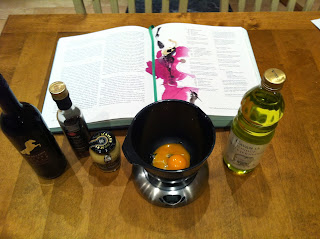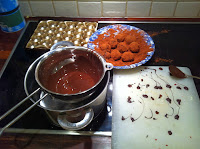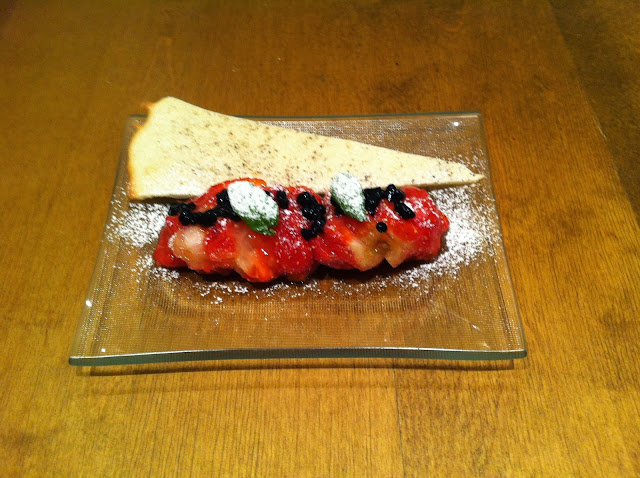This soup is a take on the traditional gazpacho soup from Spain, but it is made from, you guessed it, red cabbage. For some reason. red cabbage is only readily available in stores here in Norway around Christmas. One of Norway's favourite
Christmas dinners is rib of pork with slightly pickled red cabbage, so right now it is in all stores, but between January and November it may actually be difficult to get hold of. So in this country, this chilled summer soup is easiest made in November/December when there will be below zero temperatures outside. Not perfect, but still.
The recipe calls for 450 gams of red cabbage juice and suggests that two cabbages will produce this. So I buy three, just in case. A few years ago my wife bought a juicer. It is a Phillips appliance that so far has lived a quiet life in one corner of my kitchen top. My wife has been using it to make carrot juice other juices for drinking. I must admit I have not given it a thought. And this summer I actually stored it in the basement because nobody was using it. But now it is up in the kitchen again, ready for service.
So I start with one half of the first cabbage, cutting it into bits and forcing it through the juicer. Juice is pouring out. Lots of it. I don't know if it is my juicer that is extraordinary good or if Norwegian cabbages are much larger than others, but after one half of my first cabbage I have more than the 450 grams required!
The juice is mixed with 30 grams of white bread. This is then left in the fridge for two hours before straining. In traditional Gazpacho you use bread as a thickener, but here, Heston probably only wants the aroma and not the texture. Anyway, the cabbage part is ready.
The soup will be thickened with a red wine mayonnaise. This is a nice way to thicken soups giving a rich feel to it. The mayo is made my combining two egg yolks and 15 grams of Dijon mustard and then whisking in 180 grams of grapeseed oil. Actually the recipe calls for 36 grams of egg yolk. That is how this recipes go in the book. Nothing is left to chance. Everything is down to the exact gram, or sub-gram when it comes to things like Agar-agar or Gellan. I must admit that my two yolks weighted in at 42 grams, so sue me.
After whisking in the oil, the mayo is quite stiff. This is the time to add 15 grams of red wine vinegar and 30 grams of red wine. Well, the book says Cabernet Sauvignon vinegar, but that was not to be found in my corner of the world, so I used a good red wine vinegar. I do not know what this does to the taste of the finished product, but I do hope it does not ruin it completely.
To finish the gazpacho, mix the cabbage juice and 40 grams of the mayo and season with 15 grams of salt and 60 grams of red wine vinegar.
 Now for the mustard ice cream. 85g of egg yolks (four yolks in my
Now for the mustard ice cream. 85g of egg yolks (four yolks in my case) is whisked together with 40 caster sugar for 5 minute. 500g of whole milk is heated to 60 degrees Celsius. Actually, there should also be 25g of skimmed milk powder. I found this out after coming home from shopping, so don't tell anyone, but I am making
case) is whisked together with 40 caster sugar for 5 minute. 500g of whole milk is heated to 60 degrees Celsius. Actually, there should also be 25g of skimmed milk powder. I found this out after coming home from shopping, so don't tell anyone, but I am making it without that. when at 60 degrees, the milk is added to the eggs, and then it is all heated up to 70 again and held there for 10 minutes to pasteurize. It is then cooled and mustard is added. This recipe calls for Pommery grain mustard. Again this is something I could not get hold of. I used a strongish French grain mustard mixed with a bit of milder Norwegian grain mustard. I put the mixture in the fridge over night before I put it in my ice cream machine.
 The last bit of this puzzle is the cucumber brunois. This is made by slicing cucumber thinly lengthwise, putting the slices in a single layer in a sous vide bag and pulling a vacuum on it. This will start crushing the cell walls in the cucumber, compressing it and concentrating the flavour. This is similar to what I did to my strawberries in this post. One problem with vacuuming something moist this way with this type of machine is that liquid will be pulled into the vacuum machine. I have found that if I place a piece of kitchen paper in the opening of the bag, this will absorb the liquid but still allow the air to be sucked out. Repeating this step will concentrate the cucumber even more. The sheets are then taken out and skin and the centre core removed and the flesh cut into 2mm squares.
The last bit of this puzzle is the cucumber brunois. This is made by slicing cucumber thinly lengthwise, putting the slices in a single layer in a sous vide bag and pulling a vacuum on it. This will start crushing the cell walls in the cucumber, compressing it and concentrating the flavour. This is similar to what I did to my strawberries in this post. One problem with vacuuming something moist this way with this type of machine is that liquid will be pulled into the vacuum machine. I have found that if I place a piece of kitchen paper in the opening of the bag, this will absorb the liquid but still allow the air to be sucked out. Repeating this step will concentrate the cucumber even more. The sheets are then taken out and skin and the centre core removed and the flesh cut into 2mm squares.To put it all together, make another 80g of fresh cabbage juice and add to the gazpacho. This may sound strange. Why not just add it all in the first step? According to the chapter on juicing in volume two of Modernist Chef page 338, the distinctive aromas of a number of fruits and vegetables occur due to enzymes reacting to components that are released as cell walls break down. As these components run out, the enzymes stop working and the fresh aromas disappear. But when we add a little more fresh juice, the enzyme have new fuel to work with, and the freshness returns. To serve, place some cucumber in a bowl, place a rocher of ice cream on it and pour the soup around.
So, was it a success? The colour is fantastic. The taste is quite pungent and peppery with a bit of acidity to it. The mustard ice cream came out quite well. That may also be nice to serve with pork in some way.

.jpg)

.JPG)




.JPG)

.jpg)





































